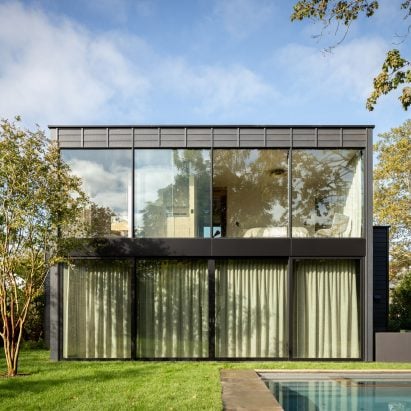Local studio Garnett DePasquale Projects has settled a compact, black-stained cedar house on a tree-lined Sag Harbor lot in the Hamptons in New York.
Known as Meadowlark, the 3,853-square-foot (358-square-metre) house was originally intended to be an extension of the clients’ neighbouring property, but turned into a standalone residence.
Garnett DePasquale Projects has completed a cedar-clad house in Sag Harbor
Garnett DePasquale Projects, which has offices in New York City and Sag Harbor, worked to fit the four-bedroom, two-bath house on a 45-degree section of the small site due to local zoning restrictions, which also pushed the house further from the street, due to its height.
Completed in 2023, Meadowlark took four years to design and build.
The back of the house features a full wall of glass on both levels
“It started with something that looked like a faux whaling museum,” principal Pete DePasquale said, explaining that the traditional gabled design morphed into a large, singular box articulated with modernist details.
The house is clad in stained cedar, “but with a nuanced, warm, sensitive approach to livability and texture”.
Various shades of green appear throughout the house
It has an almost-completely opaque front with a single door and window. Meanwhile, the rear facade is wide open with a full wall of glass on both levels.
The horizontal blackened cedar lap siding is broken into small segments with vertical battens that run from the foundation to the parapet.
“There was a lot of investigation into how stairs could work, how we could make the floor plates make sense,” principal Rebecca Garnett said, noting the balance between the open, accessible back and the private front facade.
Black and white stone in the kitchen contrasts the light wood floors
The simple form and modularity expressed in the window mullions carry through to the interior.
The program was laid out with “a real emphasis on both platonic and rational form”, according to the studio.
The entrance is centred in the plan, but the staircase completely separates the floors and divides the program in a way that orients and reorients views between the interior and the rolling landscape outside.
Various shades of green – from tile around the fireplace to a velvet sofa to a sunken lightwell – appear throughout the house, softening the modernist interiors with visual and tactile textures, while floor-to-ceiling curtains mitigate light and heat through the expansive glass.
An upper-floor bedroom looks out over a pool
Soft natural wooden floors contrast black metal columns and window frames, and black and white stone adds a flat, marbled pattern to the sleek counters in the kitchen and bathrooms.
Blackened cedar siding is found often in this area, especially in the nearby Hamptons, appearing in other recent residential projects including a renovated, multigenerational house by BarlisWedlick, a home studio extension by Worrell Yeung and a “villain’s hideout” home that interior designer Timothy Godbold designed for himself.
The photography is by Nicholas Venezia and Read McKendree, courtesy of JBSA.
Project credits:
Architect: Garnett.DePasquale
Project team: Becky Garnett, Pete DePasquale, Nicole Marple, Chris SooHoo
Interior Designer: Amy Su
Main Contractor: RLW4 Builders
Interior Contractor: RLW4 Builders
Structures: DiLandro Andrews Engineering
Lighting: Fisher Marantz Stone
MEP: RLW4 Builders
Electrical: RLW4 Builders
Mechanical: RLW4 Builders
Landscape: John Verderber, Jr. with Rachel Williams
The post Garnett DePasquale Projects wraps Hamptons house in black cedar appeared first on Dezeen.
